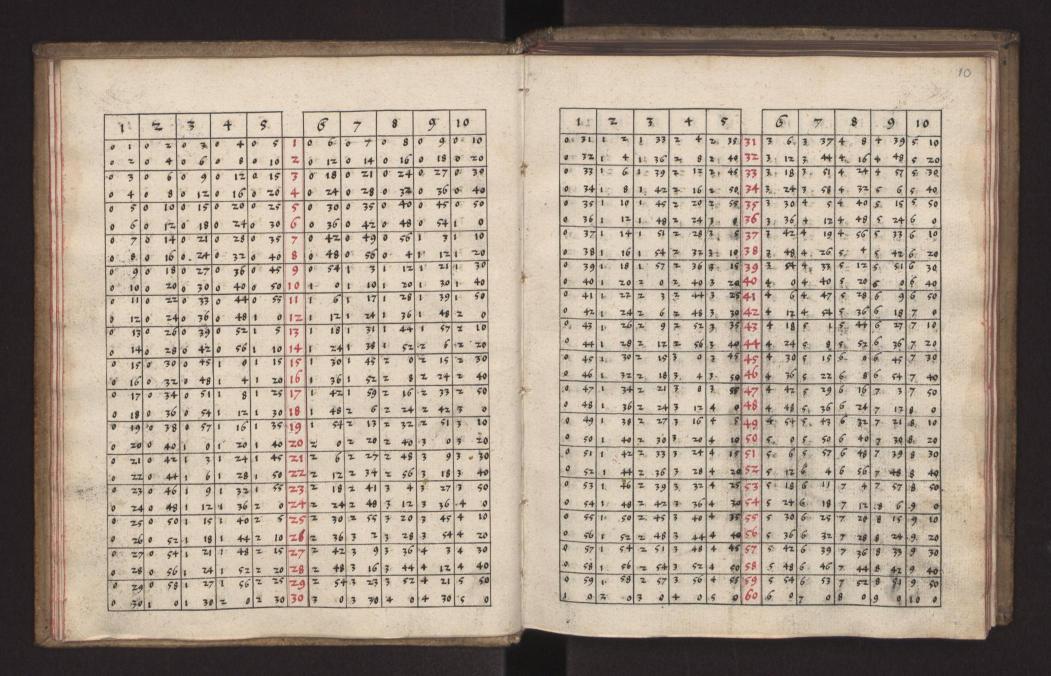
The introduction and the following images were provided by Dieter Launert for inclusion in LOCOMAT.
Bürgi's entire manuscript can be found here.
Folkerts, Launert and Thom's article is here. But read also my articles on the origin of Bürgi's algorithm, on its complexity, on the use of the method of differences for analyzing sin(1 deg) and on Bürgi's anticipation of Prony's methods.
See also our reconstructions Bürgi's sine table at 1' intervals (ca. 1587) and Bürgi's sine table at 2'' intervals (ca. 1600).
English introduction by Dieter Launert (December 2015).
It is known for a long time that the Swiss mathematician Jost Bürgi has found a new method to calculate the sines values quickly and easily but there was no information as far as details were concerned. Furthermore Bürgi calculated a sines table with a step range of 2', which, however, got lost. Now Menso Folkerts has discovered a script in Breslau (Wrocław) in which Bürgi himself describes his method. It differs fundamentally from the common geometrical procedure, which goes back to Ptolemäus’ calculation of the sines in ancient Greece. His algebraic procedure in which Bürgi only uses additions and bisections is elementary and converges quickly. Bürgi structures his solutions concerning the division of the right angle in arbitrary numerous (equal) parts, virtually an algebraic method of approximation to calculate the resulting sines values. He is for example able to divide an angle of 90 degrees into 9 parts and consequently can calculate sin 10°, sin20°, … sin80°, sin90° = 1; or he divides an angle of 90 degrees into 90 parts in order to determine the sines values of all degrees. Between these sines values the minutes will be interpolated. In the above mentioned script Bürgi wrote his sines table on 38 pages 46v to 64v with a step range of 1, plus a multiplication table in sexagesimal system on 12 pages 9v -15r. Bürgi handed his script to the Emperor Rudolph II in Prague in July 1592. It, however, originates in Kassel in 1586/87. The tables of this text are shown here. The Bürgi script of the title ‘Fundamentum Astronomiae’ is kept in the Biblioteka Uniwersytecka Wrocław, Sign. IV Qu 38a. I would like to thank the library for the permission to publish the script. It is commented and edited in ‘Nova Kepleriana’ of the Bavarian Academy of Science, philosophical-historical class, treatise new serie No.141. See also the article of Menso Folkerts/Dieter Launert/Andreas Thom, “Jost Bürgi’s Method for Calculating Sines” in the journal ‘Historia Mathematica’.
German introduction by Dieter Launert (November 2015).
Schon seit langem ist bekannt, dass der Schweizer Mathematiker Jost Bürgi eine neue Methode gefunden hat, um Sinus-Werte schnell und einfach zu berechnen, aber über Einzelheiten gab es keine Information. Außerdem hatte er damit eine Sinustabelle mit 2´´ Schrittweite berechnet, die jedoch verschollen ist. Jetzt hat Menso Folkerts in Breslau (Wrocław) eine Handschrift entdeckt, in der Bürgi selbst sein Verfahren beschreibt. Es unterscheidet sich grundsätzlich von dem üblichen geometrischen Vorgehen, das auf die Sehnenberechnung des Ptolemäus in der griechischen Antike zurückgeht. Sein algebraisches Verfahren, in dem Bürgi nur Additionen und Halbierungen benutzt, ist elementar und konvergiert schnell. Bürgi beschreibt seinen „Kunstweg“ zur Teilung des Rechten Winkels in beliebig viele (gleiche) Teile, eine algebraische Näherungsmethode zur Berechnung der sich daraus ergebenden Sinuswerte. Er kann zum Beispiel den 90°-Winkel in 9 Teile teilen und damit sin 10°, sin 20°, ... sin 80°, sin 90° = 1 berechnen; oder er teilt den 90°-Winkel in 90 Teile, um somit die Sinuswerte aller ganzen Grade zu ermitteln; zwischen diesen Sinuswerten werden dann die Minuten interpoliert. In der oben erwähnten Handschrift hat Bürgi seine Sinus-Tabelle mit Schrittweite 1´ auf den 38 Seiten 46v bis 64r geschrieben, zusätzlich eine Multiplikationstabelle im Hexagesimalsystem auf den 12 Seiten 9v-15r. Bürgi übergab seine Handschrift im Juli 1592 Kaiser Rudolph II. in Prag, sie entstand jedoch schon 1586/87 in Kassel. Die Tabellen aus dieser Handschrift werden hier gezeigt. Die Bürgi-Handschrift mit dem Titel „Fundamentum Astronomiae“ liegt in der Biblioteka Uniwersytecka Wrocław, Sign. IV Qu 38a. Ich danke für die Genehmigung zur Veröffentlichung. Die Handschrift wird kommentiert ediert in der Reihe Nova Kepleriana der Bayerischen Akademie der Wissenschaften, Philosophisch-historische Klasse, Abhandlungen Neue Folge Nr. 141. Siehe dazu auch den Artikel von Menso Folkerts/Dieter Launert/Andreas Thom, Jost Bürgi´s Method for Calculating Sines in der Zeitschrift Historia Mathematica.
Last update: D. Roegel, 27 march 2016
Return to the main page.
This page is located at http://locomat.loria.fr/